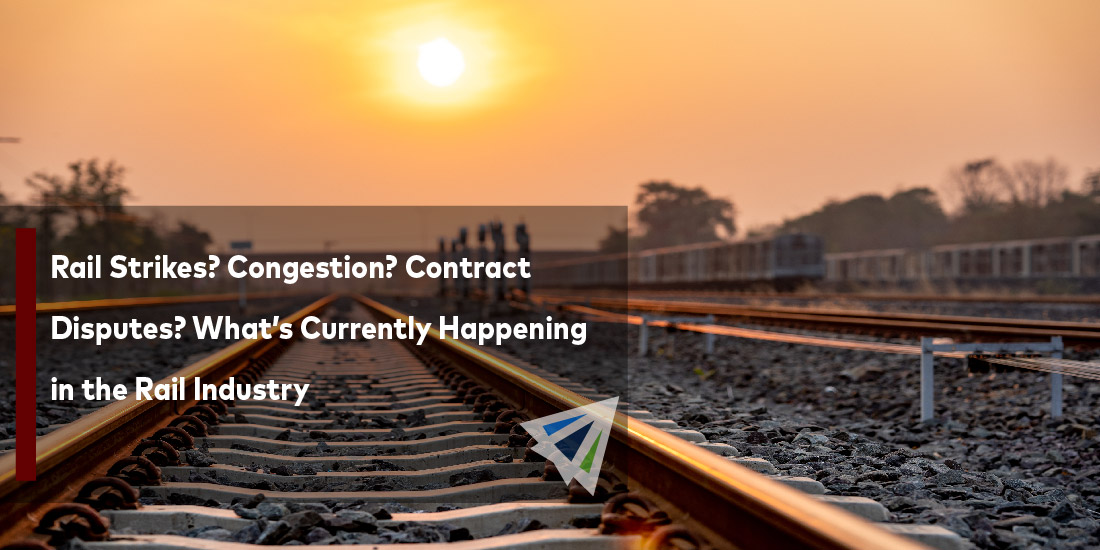Rail Strikes? Congestion? Contract Disputes? What’s Currently Happening in the Rail Industry
A lot has been happening in the rail industry so far this year. Potential rail strikes, congestion issues, and contract disputes are some of the main topics in the news currently.
Rail Strikes and Contract Disputes
On July 15, President Biden stepped in and signed an executive order, thwarting the potential of a strike by U.S. railway workers – which would have been the first rail strike since 1992 – and created a Presidential Emergency Board (PEB). Many feared, including the U.S. Chamber of Commerce, that if the President did not step in and the strike occurred, that it would result in significant disruptions throughout the supply chain. Now, with the executive order, it prevents the Brotherhood of Locomotive Engineers and Trainmen from striking and 12 other unions from engaging in secondary picketing, which is around 155,000 workers, the Journal of Commerce reports. Furthermore, these negotiations between the rail unions and their employers have been going on since January 2020, with negotiations now in a “dead end” two years later.
Some of the topics of discussion between the parties are whether one-person train crews should be permitted, how automation might affect job responsibilities down the road, and raises that will offset inflation and cover increased health insurance costs amidst the ongoing worker shortages.
With the Presidential Emergency Board being in place, this gives arbitrators time to hold hearings with both sides to gather more information before they issue their recommendations in about a month or so from now. After that, the unions and the railroads will have 30 days to negotiate a new deal before a strike could be permitted under the federal law that would allow that, Transport Topics notes. However, if that were to happen more likely than not Congress would step in quickly to prevent a strike by voting to impose terms or taking other action.
Ongoing Congestion and Labor Shortages
Some speculate that if a new deal is reached, it would help the railroads hire more workers, which has been an ongoing struggle for them. With the increased demand as the economy is attempting to recover, along with dealing with many delays and missed deliveries plaguing their service throughout this year, many of the major railroads have said they do need to hire hundreds more workers to deal with specific issues.
For reference, the average railroader earns $135,000 annually in total pay and benefits, per the Association of American Railroads. With Ian Jefferies, AAR President and CEO adding that, “railroads remain committed to reaching an agreement that provides their employees well-deserved compensation increases that keep them among the best paid in the nation.”
As with all jobs, there comes challenges and that is no different with being a railroad crew member. Some compare the job to airline pilots, with having to operate massive and sometimes dangerous pieces of equipment. On top of that, they have to be away from their families’ days at a time and potentially being on call even when they are home with their families.
Congestion has also played a role this year where some industries have expressed frustration regarding in service capacity from the railroads. As well as having to spend multi-millions of dollars more in shipping costs in order to get their product moved while still dealing with poor service, FreightWaves reports. In an effort to get answers from railroad executives regarding these issues and more, the Surface Transportation Board held a two-day hearing back in May with them – however, the verdict is still out on if that hearing has helped ease tensions or not.
Todd Tranausky, Vice President of Rail and Intermodal at FTR Transportation Intelligence, has stated that the railroads cut too much staff during the adoption of precision scheduled railroading (PSR) and the pandemic. He continues to say that because of those things, rail employment today is down more than 20 percent since the beginning of 2019, which is a dramatic decline – as reported by FreightWaves.
At the same time, there are some things that are outside the control of the railroads. For example, many warehouses this year are packed more with inventory than they were last year. Some experts have even said that some shippers are using railcars as storage rather than moving the cargo into their own warehouses. This has caused a shortage of chassis which has increased the congestion at some rail yards.
Looking Ahead
We will continue to stay up to date regarding this topic and make sure to keep you informed and updated as things change.
As always, if you would like more information regarding this topic, contact our team at InterlogUSA and we will be happy to assist you on any questions or comments you may have! In addition, we have our weekly market updates that can provide you with relevant freight news, updates, developments across the industry, and more.
